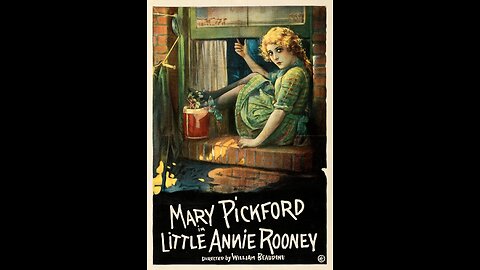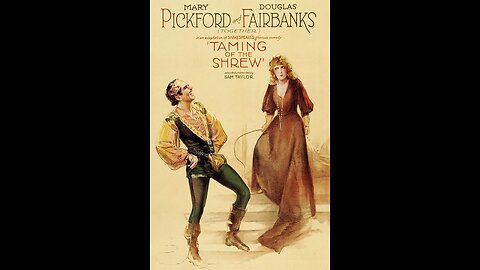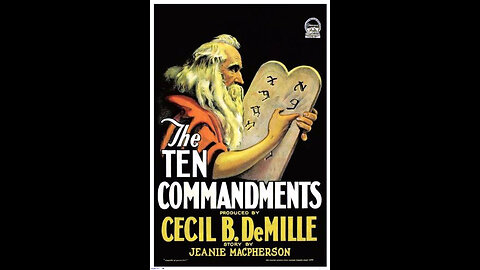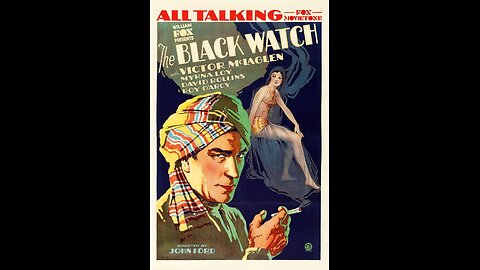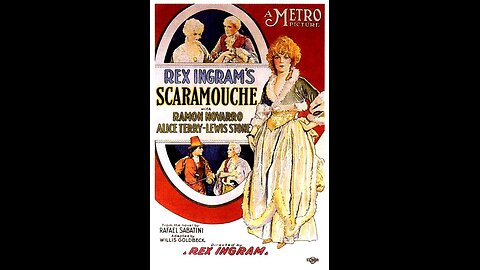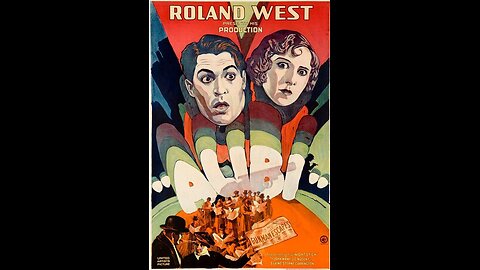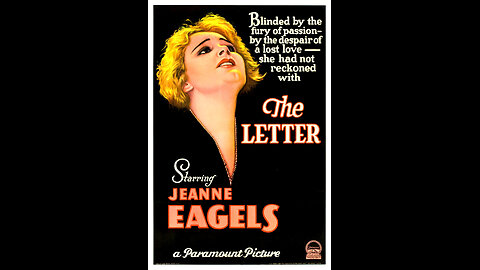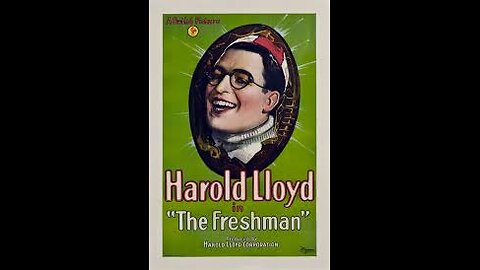
1920-1929 Movies
15 videos
Updated 2 months ago
The Best of Anglo American Films from 1920-1929
-
The Freshman / College Days (1925) | Directed by Fred C. Newmeyer & Sam Taylor
 Classic Films & Movies ArchiveA classic silent comedy about an eager but socially awkward college freshman who tries to gain popularity and the affection of a girl by joining the football team. His misguided efforts, comic mishaps, and eventual triumph made the film one of Harold Lloyd’s most celebrated works. Genre: Silent Comedy Director: Fred C. Newmeyer and Sam Taylor Fred C. Newmeyer (1888–1967) was an American actor turned director best known for his work on Harold Lloyd’s films, including Safety Last! and Girl Shy. Sam Taylor (1895–1958) was a screenwriter and director who collaborated frequently with Lloyd and later directed Mary Pickford and other major stars. Together, they helped shape the golden era of silent comedy with a focus on tightly choreographed gags and character-driven humor. Star Cast: Harold Lloyd as Harold Lamb Jobyna Ralston as Peggy Brooks Benedict as The College Cad James Anderson as The College Hero Hazel Keener as The College Belle Pat Harmon as The Football Coach Joseph Harrington as Harold’s Father The Freshman was a huge box-office success and became one of the most popular films of the 1920s. Audiences connected with Harold Lloyd’s portrayal of the eager outsider, and critics praised the film’s humor and heart. It cemented Lloyd’s place alongside Charlie Chaplin and Buster Keaton as one of the great silent comedy icons. The football sequences, in particular, became legendary and influenced future sports comedies. Fun Facts: The film was so successful that it inspired many other “college comedy” films throughout the 1920s and 1930s. Harold Lloyd performed much of the physical comedy himself, including the football scenes, though some stunts used doubles. The Freshman popularized the idea of the underdog athlete who triumphs against the odds, a theme later repeated in Hollywood sports films. The movie premiered in New York City in September 1925 and was one of Lloyd’s biggest financial hits. In 1990, The Freshman was selected for preservation in the United States National Film Registry by the Library of Congress for being "culturally, historically, or aesthetically significant." * This Rumble Movie Channel is comprehensively indexed on https://kinoquick.com - find you favourite movies fast & free! * Follow this channel to be notified of daily movie updates.218 views
Classic Films & Movies ArchiveA classic silent comedy about an eager but socially awkward college freshman who tries to gain popularity and the affection of a girl by joining the football team. His misguided efforts, comic mishaps, and eventual triumph made the film one of Harold Lloyd’s most celebrated works. Genre: Silent Comedy Director: Fred C. Newmeyer and Sam Taylor Fred C. Newmeyer (1888–1967) was an American actor turned director best known for his work on Harold Lloyd’s films, including Safety Last! and Girl Shy. Sam Taylor (1895–1958) was a screenwriter and director who collaborated frequently with Lloyd and later directed Mary Pickford and other major stars. Together, they helped shape the golden era of silent comedy with a focus on tightly choreographed gags and character-driven humor. Star Cast: Harold Lloyd as Harold Lamb Jobyna Ralston as Peggy Brooks Benedict as The College Cad James Anderson as The College Hero Hazel Keener as The College Belle Pat Harmon as The Football Coach Joseph Harrington as Harold’s Father The Freshman was a huge box-office success and became one of the most popular films of the 1920s. Audiences connected with Harold Lloyd’s portrayal of the eager outsider, and critics praised the film’s humor and heart. It cemented Lloyd’s place alongside Charlie Chaplin and Buster Keaton as one of the great silent comedy icons. The football sequences, in particular, became legendary and influenced future sports comedies. Fun Facts: The film was so successful that it inspired many other “college comedy” films throughout the 1920s and 1930s. Harold Lloyd performed much of the physical comedy himself, including the football scenes, though some stunts used doubles. The Freshman popularized the idea of the underdog athlete who triumphs against the odds, a theme later repeated in Hollywood sports films. The movie premiered in New York City in September 1925 and was one of Lloyd’s biggest financial hits. In 1990, The Freshman was selected for preservation in the United States National Film Registry by the Library of Congress for being "culturally, historically, or aesthetically significant." * This Rumble Movie Channel is comprehensively indexed on https://kinoquick.com - find you favourite movies fast & free! * Follow this channel to be notified of daily movie updates.218 views -
Little Annie Rooney (1925) | Directed by William Beaudine
 Classic Films & Movies ArchiveLittle Annie Rooney is a silent comedy-drama film starring Mary Pickford, who also wrote the story under the pseudonym “Catherine Hennessey.” The film follows Annie, a spirited young girl living in the rough streets of New York’s Lower East Side, who becomes embroiled in gang rivalries and personal tragedies. Despite hardships, her resilience, charm, and belief in love help her triumph over adversity. Genre: Silent Comedy-Drama Director: William Beaudine William Beaudine (1892–1970) was a prolific American director whose career spanned both the silent and sound eras. Known as “One-Shot Beaudine” for his speed and efficiency, he directed more than 350 films and television episodes. His early career included collaborations with stars such as Mary Pickford, while his later work included low-budget films and television series like Lassie and The Green Hornet. Star Cast: Mary Pickford as Annie Rooney William Haines as Joe Kelly Walter James as Officer Callahan Gordon Griffith as Tim Rooney Spec O’Donnell as Abie Levy Lionel Belmore as Tony, the fruit vendor The film was a commercial success, largely thanks to Mary Pickford’s enduring popularity. Audiences adored her performance, even though she was in her thirties portraying a teenager. Critics noted the sentimental and melodramatic elements, but the combination of gritty urban settings and Pickford’s charm resonated with viewers. The film further cemented her image as “America’s Sweetheart,” appealing to fans worldwide. Fun Facts: Mary Pickford, then in her early thirties, convincingly played the teenage Annie Rooney, showcasing her ability to embody youthful characters. Pickford personally wrote the story for the film under the pseudonym “Catherine Hennessey,” adding to her creative control. The movie was filmed on elaborate studio sets that recreated New York’s Lower East Side with remarkable detail. The success of Little Annie Rooney came during the peak of Pickford’s career, when she was one of the most powerful women in Hollywood and co-founder of United Artists. The film was restored in 2014 by the Academy Film Archive in association with the Mary Pickford Foundation, bringing back its vibrant tinting and clarity for modern audiences. * This Rumble Movie Channel is comprehensively indexed on https://kinoquick.com - find you favourite movies fast & free! * Follow this channel to be notified of daily movie updates.181 views
Classic Films & Movies ArchiveLittle Annie Rooney is a silent comedy-drama film starring Mary Pickford, who also wrote the story under the pseudonym “Catherine Hennessey.” The film follows Annie, a spirited young girl living in the rough streets of New York’s Lower East Side, who becomes embroiled in gang rivalries and personal tragedies. Despite hardships, her resilience, charm, and belief in love help her triumph over adversity. Genre: Silent Comedy-Drama Director: William Beaudine William Beaudine (1892–1970) was a prolific American director whose career spanned both the silent and sound eras. Known as “One-Shot Beaudine” for his speed and efficiency, he directed more than 350 films and television episodes. His early career included collaborations with stars such as Mary Pickford, while his later work included low-budget films and television series like Lassie and The Green Hornet. Star Cast: Mary Pickford as Annie Rooney William Haines as Joe Kelly Walter James as Officer Callahan Gordon Griffith as Tim Rooney Spec O’Donnell as Abie Levy Lionel Belmore as Tony, the fruit vendor The film was a commercial success, largely thanks to Mary Pickford’s enduring popularity. Audiences adored her performance, even though she was in her thirties portraying a teenager. Critics noted the sentimental and melodramatic elements, but the combination of gritty urban settings and Pickford’s charm resonated with viewers. The film further cemented her image as “America’s Sweetheart,” appealing to fans worldwide. Fun Facts: Mary Pickford, then in her early thirties, convincingly played the teenage Annie Rooney, showcasing her ability to embody youthful characters. Pickford personally wrote the story for the film under the pseudonym “Catherine Hennessey,” adding to her creative control. The movie was filmed on elaborate studio sets that recreated New York’s Lower East Side with remarkable detail. The success of Little Annie Rooney came during the peak of Pickford’s career, when she was one of the most powerful women in Hollywood and co-founder of United Artists. The film was restored in 2014 by the Academy Film Archive in association with the Mary Pickford Foundation, bringing back its vibrant tinting and clarity for modern audiences. * This Rumble Movie Channel is comprehensively indexed on https://kinoquick.com - find you favourite movies fast & free! * Follow this channel to be notified of daily movie updates.181 views -
The Taming of the Shrew (1929) | Directed by Sam Taylor
 Classic Films & Movies Archive"The Taming of the Shrew" is a romantic comedy adapted from William Shakespeare’s play of the same name. Set in Renaissance Italy, it tells the story of the boisterous and headstrong Katharina and her turbulent relationship with the equally fiery Petruchio, who seeks to "tame" her into a compliant wife. This 1929 film was among the earliest talkies to adapt Shakespeare for the screen, offering a theatrical and stylized interpretation with the novelty of synchronized sound. Genre: Romantic Comedy, Historical Drama, Shakespeare Adaptation Director: Sam Taylor Sam Taylor was an American film director and screenwriter known primarily for his work during the silent and early sound eras. Born in 1895, Taylor directed several successful comedies in the 1920s, often working with stars like Harold Lloyd. While not a Shakespeare specialist, Taylor was selected to helm this early sound adaptation of the Bard, notable for its high-profile cast and ambitious production. His direction emphasized theatrical flair and performance over cinematic innovation. Star Cast: * Mary Pickford as Katharina * Douglas Fairbanks as Petruchio Public Reaction: The film generated significant public interest due to the casting of Mary Pickford and Douglas Fairbanks, the most famous Hollywood couple of the silent era. However, critical reception was mixed. Audiences were fascinated by the novelty of hearing Shakespeare spoken in a motion picture, but many critics found the film’s theatrical style and stiff delivery awkward. The strained personal relationship between Pickford and Fairbanks—reflected in their performances—added a layer of fascination and tension for contemporary viewers. The film did not perform well at the box office and was considered a misstep in both stars’ careers during the transitional period from silent to sound film. Fun Facts: * It was the first feature-length Shakespeare adaptation made in the sound era and the only film in which Mary Pickford and Douglas Fairbanks appeared together. * The film was famously marketed with the line: "By William Shakespeare, with additional dialogue by Sam Taylor." * Pickford and Fairbanks were in the midst of a troubled marriage during filming, and their real-life animosity may have influenced their on-screen chemistry. * Critics at the time were divided on whether the spoken dialogue improved or hindered the film’s impact, as early sound recording technology was still primitive. * The film was considered lost for many years until a print was rediscovered and restored, offering valuable insight into early sound filmmaking and Shakespeare on screen. * This Rumble Movie Channel is comprehensively indexed on https://kinoquick.com - find you favourite movies fast & free! * Follow this channel to be notified of daily movie updates.305 views
Classic Films & Movies Archive"The Taming of the Shrew" is a romantic comedy adapted from William Shakespeare’s play of the same name. Set in Renaissance Italy, it tells the story of the boisterous and headstrong Katharina and her turbulent relationship with the equally fiery Petruchio, who seeks to "tame" her into a compliant wife. This 1929 film was among the earliest talkies to adapt Shakespeare for the screen, offering a theatrical and stylized interpretation with the novelty of synchronized sound. Genre: Romantic Comedy, Historical Drama, Shakespeare Adaptation Director: Sam Taylor Sam Taylor was an American film director and screenwriter known primarily for his work during the silent and early sound eras. Born in 1895, Taylor directed several successful comedies in the 1920s, often working with stars like Harold Lloyd. While not a Shakespeare specialist, Taylor was selected to helm this early sound adaptation of the Bard, notable for its high-profile cast and ambitious production. His direction emphasized theatrical flair and performance over cinematic innovation. Star Cast: * Mary Pickford as Katharina * Douglas Fairbanks as Petruchio Public Reaction: The film generated significant public interest due to the casting of Mary Pickford and Douglas Fairbanks, the most famous Hollywood couple of the silent era. However, critical reception was mixed. Audiences were fascinated by the novelty of hearing Shakespeare spoken in a motion picture, but many critics found the film’s theatrical style and stiff delivery awkward. The strained personal relationship between Pickford and Fairbanks—reflected in their performances—added a layer of fascination and tension for contemporary viewers. The film did not perform well at the box office and was considered a misstep in both stars’ careers during the transitional period from silent to sound film. Fun Facts: * It was the first feature-length Shakespeare adaptation made in the sound era and the only film in which Mary Pickford and Douglas Fairbanks appeared together. * The film was famously marketed with the line: "By William Shakespeare, with additional dialogue by Sam Taylor." * Pickford and Fairbanks were in the midst of a troubled marriage during filming, and their real-life animosity may have influenced their on-screen chemistry. * Critics at the time were divided on whether the spoken dialogue improved or hindered the film’s impact, as early sound recording technology was still primitive. * The film was considered lost for many years until a print was rediscovered and restored, offering valuable insight into early sound filmmaking and Shakespeare on screen. * This Rumble Movie Channel is comprehensively indexed on https://kinoquick.com - find you favourite movies fast & free! * Follow this channel to be notified of daily movie updates.305 views -
The Ten Commandments (1923) | Directed by Cecil B. DeMille
 Classic Films & Movies ArchiveThe Ten Commandments is a silent-era epic that tells two stories: one set in biblical times and the other in the modern day. The first part dramatizes the story of Moses leading the Israelites out of Egypt, receiving the Ten Commandments from God. The second part shifts to a contemporary tale about two brothers, one of whom breaks the commandments and suffers dire consequences, reinforcing the moral lessons of the biblical narrative. Genre: Historical Epic, Religious Drama Director: Cecil B. DeMille Cecil B. DeMille was a towering figure in early Hollywood, known for his lavish productions, religious epics, and grand storytelling. A pioneer of American cinema, he directed both silent films and talkies with a flair for spectacle and morality. His career spanned over four decades, culminating in the 1956 remake of The Ten Commandments, which became one of his most famous works. Star Cast: Theodore Roberts as Moses Charles de Rochefort as Pharaoh Rameses Estelle Taylor as Miriam Richard Dix as John McTavish (modern story) Rod La Rocque as Dan McTavish (modern story) Leatrice Joy as Mary Leigh Audiences in 1923 were astounded by the film’s scale and ambition, especially its groundbreaking special effects and massive sets, including a full-size Egyptian city built in the Guadalupe-Nipomo Dunes in California. Critics praised DeMille’s ability to blend religious reverence with cinematic spectacle. The film was a major box office success and helped cement DeMille’s reputation as a master of the epic genre. Fun Facts: * The elaborate sets for the Egyptian scenes were buried in the California desert after filming, where remnants still remain and are known as the “Lost City of DeMille.” * The movie’s dual structure—half biblical epic, half contemporary morality tale—was highly unusual for the time. * DeMille reused several of the special effects techniques in later productions, pioneering many visual tricks of early cinema. * This film laid the foundation for DeMille’s later remake in 1956, which was a full-color sound version and became a staple of religious cinema. * This Rumble Movie Channel is comprehensively indexed on https://kinoquick.com - find you favourite movies fast & free! * Follow this channel to be notified of daily movie updates.372 views
Classic Films & Movies ArchiveThe Ten Commandments is a silent-era epic that tells two stories: one set in biblical times and the other in the modern day. The first part dramatizes the story of Moses leading the Israelites out of Egypt, receiving the Ten Commandments from God. The second part shifts to a contemporary tale about two brothers, one of whom breaks the commandments and suffers dire consequences, reinforcing the moral lessons of the biblical narrative. Genre: Historical Epic, Religious Drama Director: Cecil B. DeMille Cecil B. DeMille was a towering figure in early Hollywood, known for his lavish productions, religious epics, and grand storytelling. A pioneer of American cinema, he directed both silent films and talkies with a flair for spectacle and morality. His career spanned over four decades, culminating in the 1956 remake of The Ten Commandments, which became one of his most famous works. Star Cast: Theodore Roberts as Moses Charles de Rochefort as Pharaoh Rameses Estelle Taylor as Miriam Richard Dix as John McTavish (modern story) Rod La Rocque as Dan McTavish (modern story) Leatrice Joy as Mary Leigh Audiences in 1923 were astounded by the film’s scale and ambition, especially its groundbreaking special effects and massive sets, including a full-size Egyptian city built in the Guadalupe-Nipomo Dunes in California. Critics praised DeMille’s ability to blend religious reverence with cinematic spectacle. The film was a major box office success and helped cement DeMille’s reputation as a master of the epic genre. Fun Facts: * The elaborate sets for the Egyptian scenes were buried in the California desert after filming, where remnants still remain and are known as the “Lost City of DeMille.” * The movie’s dual structure—half biblical epic, half contemporary morality tale—was highly unusual for the time. * DeMille reused several of the special effects techniques in later productions, pioneering many visual tricks of early cinema. * This film laid the foundation for DeMille’s later remake in 1956, which was a full-color sound version and became a staple of religious cinema. * This Rumble Movie Channel is comprehensively indexed on https://kinoquick.com - find you favourite movies fast & free! * Follow this channel to be notified of daily movie updates.372 views -
The Black Watch (1929) | Directed by John Ford
 Classic Films & Movies ArchiveThe Black Watch is a war adventure drama set during the early days of World War I. The story follows a British Army officer, Captain Donald King, who is assigned a secret mission in India just as his regiment, the famous Black Watch, is sent to the front lines in Europe. Though misunderstood and labelled a coward for staying behind, King undertakes a dangerous undercover operation to help thwart a tribal uprising in the British Raj. Genre: War, Adventure, Drama Director: John Ford John Ford was one of the most influential directors in American cinema history. Born in 1894, he directed over 140 films in a career spanning more than 50 years. Ford is best known for his Westerns, including Stagecoach, The Searchers, and The Man Who Shot Liberty Valance, as well as for his four Academy Awards for Best Director. Known for his visual storytelling, use of natural landscapes, and strong moral themes, Ford began directing silent films before transitioning into talkies with The Black Watch as his first sound feature. Star Cast: - Victor McLaglen as Captain Donald King - Myrna Loy as Yasmani - Francis Ford as Major MacGregor - Lumsden Hare as Colonel Gregory - David Rollins as Lieutenant Malcolm - Roy D'Arcy as Rewa Ghunga The Black Watch received mixed to positive reactions upon its release, largely because it marked John Ford's transition from silent to sound films. Victor McLaglen was praised for his performance, and audiences enjoyed the film’s exotic setting and action sequences. Critics noted the uneven pacing but appreciated the film's ambition and scope. It was an early talkie that managed to hold public interest during a time of great change in the film industry. Fun Facts: - The Black Watch was John Ford’s first sound film. - The story was based on the novel “King of the Khyber Rifles” by Talbot Mundy. - Myrna Loy, who played Yasmani, was in the early stages of her career and would later become a major Hollywood star. - Francis Ford, who played Major MacGregor, was John Ford’s older brother and appeared in many of his films. - The movie features elaborate sets and costumes depicting British India, which were considered visually impressive for the time. - It was produced by Fox Film Corporation before its merger with Twentieth Century Pictures. * This Rumble Movie Channel is comprehensively indexed on https://kinoquick.com - find you favourite movies fast & free! * Follow this channel to be notified of daily movie updates.507 views
Classic Films & Movies ArchiveThe Black Watch is a war adventure drama set during the early days of World War I. The story follows a British Army officer, Captain Donald King, who is assigned a secret mission in India just as his regiment, the famous Black Watch, is sent to the front lines in Europe. Though misunderstood and labelled a coward for staying behind, King undertakes a dangerous undercover operation to help thwart a tribal uprising in the British Raj. Genre: War, Adventure, Drama Director: John Ford John Ford was one of the most influential directors in American cinema history. Born in 1894, he directed over 140 films in a career spanning more than 50 years. Ford is best known for his Westerns, including Stagecoach, The Searchers, and The Man Who Shot Liberty Valance, as well as for his four Academy Awards for Best Director. Known for his visual storytelling, use of natural landscapes, and strong moral themes, Ford began directing silent films before transitioning into talkies with The Black Watch as his first sound feature. Star Cast: - Victor McLaglen as Captain Donald King - Myrna Loy as Yasmani - Francis Ford as Major MacGregor - Lumsden Hare as Colonel Gregory - David Rollins as Lieutenant Malcolm - Roy D'Arcy as Rewa Ghunga The Black Watch received mixed to positive reactions upon its release, largely because it marked John Ford's transition from silent to sound films. Victor McLaglen was praised for his performance, and audiences enjoyed the film’s exotic setting and action sequences. Critics noted the uneven pacing but appreciated the film's ambition and scope. It was an early talkie that managed to hold public interest during a time of great change in the film industry. Fun Facts: - The Black Watch was John Ford’s first sound film. - The story was based on the novel “King of the Khyber Rifles” by Talbot Mundy. - Myrna Loy, who played Yasmani, was in the early stages of her career and would later become a major Hollywood star. - Francis Ford, who played Major MacGregor, was John Ford’s older brother and appeared in many of his films. - The movie features elaborate sets and costumes depicting British India, which were considered visually impressive for the time. - It was produced by Fox Film Corporation before its merger with Twentieth Century Pictures. * This Rumble Movie Channel is comprehensively indexed on https://kinoquick.com - find you favourite movies fast & free! * Follow this channel to be notified of daily movie updates.507 views -
Scaramouche (1923) | Directed by Rex Ingram
 Classic Films & Movies Archive"Scaramouche" is a silent historical drama set during the French Revolution, following the story of André-Louis Moreau, a lawyer turned revolutionary who adopts the identity of a theatrical clown named Scaramouche. After witnessing the murder of his best friend by a ruthless aristocrat, André seeks justice by joining a traveling acting troupe and eventually becomes a skilled swordsman. The film combines political intrigue, romance, and swashbuckling action in a story of identity, revenge, and redemption. Genre: Historical Drama, Adventure, Romance Director: Rex Ingram Rex Ingram was a prominent American film director during the silent era, born on October 15, 1892, in Dublin, Ireland. Known for his visual flair and grand storytelling, Ingram rose to fame with films like "The Four Horsemen of the Apocalypse" (1921) and "The Prisoner of Zenda" (1922). His work often featured elaborate sets, romantic themes, and sweeping cinematography. Ingram was highly influential in shaping early Hollywood epic filmmaking, and "Scaramouche" is widely regarded as one of his most visually impressive works. He eventually moved to Europe, where he continued to make films and mentor young talent. Star Cast: - Ramón Novarro as André-Louis Moreau / Scaramouche - Alice Terry as Aline de Kercadiou - Lewis Stone as Marquis de la Tour d’Azyr - Lloyd Ingraham as Georges de Kercadiou - Julia Swayne Gordon as Madame de Plougastel - William Humphrey as Danton "Scaramouche" was a critical and commercial success upon its release. Audiences were captivated by its lavish production design, compelling performances, and thrilling sword fights. The film solidified Ramón Novarro's status as a leading man and is considered one of Rex Ingram's masterpieces. Film historians have praised its visual composition and dramatic intensity, and it remains a landmark in silent cinema for its scale and ambition. Fun Facts: - The film was based on the 1921 novel of the same name by Rafael Sabatini, which was a bestseller at the time. - Ramón Novarro performed many of his own stunts, including complex fencing scenes. - The production featured elaborate period costumes and sets that contributed to its high production cost. - Ingram’s wife, Alice Terry, played the female lead and appeared in many of his films. - "Scaramouche" influenced later swashbuckler films and was remade in 1952 as a Technicolor sound film. - The movie is often noted for its blend of theatricality and political commentary, making it stand out among other historical dramas of the era. * This Rumble Movie Channel is comprehensively indexed on https://kinoquick.com - find you favourite movies fast & free! * Follow this channel to be notified of daily movie updates.524 views 1 comment
Classic Films & Movies Archive"Scaramouche" is a silent historical drama set during the French Revolution, following the story of André-Louis Moreau, a lawyer turned revolutionary who adopts the identity of a theatrical clown named Scaramouche. After witnessing the murder of his best friend by a ruthless aristocrat, André seeks justice by joining a traveling acting troupe and eventually becomes a skilled swordsman. The film combines political intrigue, romance, and swashbuckling action in a story of identity, revenge, and redemption. Genre: Historical Drama, Adventure, Romance Director: Rex Ingram Rex Ingram was a prominent American film director during the silent era, born on October 15, 1892, in Dublin, Ireland. Known for his visual flair and grand storytelling, Ingram rose to fame with films like "The Four Horsemen of the Apocalypse" (1921) and "The Prisoner of Zenda" (1922). His work often featured elaborate sets, romantic themes, and sweeping cinematography. Ingram was highly influential in shaping early Hollywood epic filmmaking, and "Scaramouche" is widely regarded as one of his most visually impressive works. He eventually moved to Europe, where he continued to make films and mentor young talent. Star Cast: - Ramón Novarro as André-Louis Moreau / Scaramouche - Alice Terry as Aline de Kercadiou - Lewis Stone as Marquis de la Tour d’Azyr - Lloyd Ingraham as Georges de Kercadiou - Julia Swayne Gordon as Madame de Plougastel - William Humphrey as Danton "Scaramouche" was a critical and commercial success upon its release. Audiences were captivated by its lavish production design, compelling performances, and thrilling sword fights. The film solidified Ramón Novarro's status as a leading man and is considered one of Rex Ingram's masterpieces. Film historians have praised its visual composition and dramatic intensity, and it remains a landmark in silent cinema for its scale and ambition. Fun Facts: - The film was based on the 1921 novel of the same name by Rafael Sabatini, which was a bestseller at the time. - Ramón Novarro performed many of his own stunts, including complex fencing scenes. - The production featured elaborate period costumes and sets that contributed to its high production cost. - Ingram’s wife, Alice Terry, played the female lead and appeared in many of his films. - "Scaramouche" influenced later swashbuckler films and was remade in 1952 as a Technicolor sound film. - The movie is often noted for its blend of theatricality and political commentary, making it stand out among other historical dramas of the era. * This Rumble Movie Channel is comprehensively indexed on https://kinoquick.com - find you favourite movies fast & free! * Follow this channel to be notified of daily movie updates.524 views 1 comment -
Alibi (1929) | Directed by Roland West
 Classic Films & Movies ArchiveAlibi tells the story of Chick Williams, a gangster recently released from prison who tries to maintain an innocent front while being closely watched by the police. When a cop is murdered, Chick becomes the prime suspect. As the investigation unfolds, questions of justice, deception, and loyalty take center stage in this early sound-era crime drama. Genre: Crime, Drama, Mystery Director: Roland West Roland West (1885–1952) was an American film director and screenwriter known for his work in the silent and early sound film eras. He was recognized for his visual style, particularly in the crime and mystery genres. West's career included notable films such as The Bat and Alibi, the latter of which was one of the first gangster films to use synchronized sound innovatively. His career was relatively short, and he retired early from filmmaking under mysterious circumstances, partly due to rumors surrounding the death of actress Thelma Todd. Star Cast: - Chester Morris as Chick Williams - Eleanor Griffith as Joan Manning - Regis Toomey as Danny McGann - Purnell Pratt as Police Sgt. Pete Manning - Harry Stubbs as Buck Bachman - Mae Busch as Daisy Thomas Upon its release, Alibi was praised for its innovative use of sound and atmospheric cinematography. Audiences were drawn to its gritty depiction of crime and the performance of Chester Morris, who received an Academy Award nomination for Best Actor. The film stood out in the early sound era for its moody lighting, stylized set pieces, and ambitious narrative structure. Fun Facts: - Alibi was one of the first sound films to incorporate expressionistic lighting and set design influenced by German cinema. - Chester Morris received an Oscar nomination for his role, and the film also earned nominations for Best Picture and Best Art Direction. - The film was based on the stage play "Nightstick" by John Wray, J. Harold Murray, and Elaine Sterne Carrington. - Director Roland West experimented with camera movement and sound effects, which were still novel in 1929, to heighten suspense and mood. - Alibi is considered a precursor to the classic American gangster film genre that would flourish in the 1930s. * This Rumble Movie Channel is comprehensively indexed on https://kinoquick.com - find you favourite movies fast & free! * Follow this channel to be notified of daily movie updates.538 views
Classic Films & Movies ArchiveAlibi tells the story of Chick Williams, a gangster recently released from prison who tries to maintain an innocent front while being closely watched by the police. When a cop is murdered, Chick becomes the prime suspect. As the investigation unfolds, questions of justice, deception, and loyalty take center stage in this early sound-era crime drama. Genre: Crime, Drama, Mystery Director: Roland West Roland West (1885–1952) was an American film director and screenwriter known for his work in the silent and early sound film eras. He was recognized for his visual style, particularly in the crime and mystery genres. West's career included notable films such as The Bat and Alibi, the latter of which was one of the first gangster films to use synchronized sound innovatively. His career was relatively short, and he retired early from filmmaking under mysterious circumstances, partly due to rumors surrounding the death of actress Thelma Todd. Star Cast: - Chester Morris as Chick Williams - Eleanor Griffith as Joan Manning - Regis Toomey as Danny McGann - Purnell Pratt as Police Sgt. Pete Manning - Harry Stubbs as Buck Bachman - Mae Busch as Daisy Thomas Upon its release, Alibi was praised for its innovative use of sound and atmospheric cinematography. Audiences were drawn to its gritty depiction of crime and the performance of Chester Morris, who received an Academy Award nomination for Best Actor. The film stood out in the early sound era for its moody lighting, stylized set pieces, and ambitious narrative structure. Fun Facts: - Alibi was one of the first sound films to incorporate expressionistic lighting and set design influenced by German cinema. - Chester Morris received an Oscar nomination for his role, and the film also earned nominations for Best Picture and Best Art Direction. - The film was based on the stage play "Nightstick" by John Wray, J. Harold Murray, and Elaine Sterne Carrington. - Director Roland West experimented with camera movement and sound effects, which were still novel in 1929, to heighten suspense and mood. - Alibi is considered a precursor to the classic American gangster film genre that would flourish in the 1930s. * This Rumble Movie Channel is comprehensively indexed on https://kinoquick.com - find you favourite movies fast & free! * Follow this channel to be notified of daily movie updates.538 views -
7th Heaven
 Classic Films & Movies Archive"7th Heaven" (1927), directed by Frank Borzage, is a silent romantic drama that stands as a classic of early Hollywood cinema. Starring Janet Gaynor and Charles Farrell, the film tells a heartfelt story of love and redemption against the backdrop of post-World War I Paris. Janet Gaynor and Charles Farrell deliver captivating performances as Diane and Chico, respectively, portraying characters who find solace and salvation in each other's presence. Their on-screen chemistry is palpable, and their expressive performances contribute to the film's emotional impact. Frank Borzage's direction in "7th Heaven" reflects the artistry of silent cinema, emphasizing visual storytelling and evocative imagery. Borzage effectively captures the essence of Austin Strong's play, infusing the film with a sense of romance and optimism. The director's use of symbolism and his ability to convey emotions through the actors' expressions showcase the unique power of silent filmmaking. The film's narrative unfolds in a postwar Parisian setting, exploring themes of love, faith, and the human capacity for transformation. The depiction of Diane and Chico's journey from despair to hope is skillfully conveyed through Borzage's direction, creating a poignant and emotionally resonant experience for the audience. The supporting cast, including Ben Bard as the Police Officer, Albert Gran as the Sewer Rat, and David Butler as the Young Officer, complements the central romance, contributing to the film's overall charm. Each character adds depth to the portrayal of the community in which Diane and Chico navigate their challenges. "7th Heaven" received critical acclaim upon its release and went on to win three Academy Awards at the inaugural Oscar ceremony in 1929. Janet Gaynor won the Best Actress Oscar for her performances in three films, including "7th Heaven," and the film also received awards for Best Director (Frank Borzage) and Best Adaptation (Austin Strong). The cinematography, credited to Ernest Palmer and Joseph A. Valentine, captures the atmospheric beauty of Paris, utilizing light and shadow to enhance the emotional resonance of the narrative. The film's visual aesthetics contribute to its enduring appeal as a classic of the silent era. In conclusion, "Seventh Heaven" (1927) is a masterful silent film that exemplifies the emotional potency of early Hollywood cinema. Directed by Frank Borzage and starring Janet Gaynor and Charles Farrell, the film's timeless portrayal of love and redemption continues to resonate with audiences, earning its place as a classic in the history of American filmmaking.153 views
Classic Films & Movies Archive"7th Heaven" (1927), directed by Frank Borzage, is a silent romantic drama that stands as a classic of early Hollywood cinema. Starring Janet Gaynor and Charles Farrell, the film tells a heartfelt story of love and redemption against the backdrop of post-World War I Paris. Janet Gaynor and Charles Farrell deliver captivating performances as Diane and Chico, respectively, portraying characters who find solace and salvation in each other's presence. Their on-screen chemistry is palpable, and their expressive performances contribute to the film's emotional impact. Frank Borzage's direction in "7th Heaven" reflects the artistry of silent cinema, emphasizing visual storytelling and evocative imagery. Borzage effectively captures the essence of Austin Strong's play, infusing the film with a sense of romance and optimism. The director's use of symbolism and his ability to convey emotions through the actors' expressions showcase the unique power of silent filmmaking. The film's narrative unfolds in a postwar Parisian setting, exploring themes of love, faith, and the human capacity for transformation. The depiction of Diane and Chico's journey from despair to hope is skillfully conveyed through Borzage's direction, creating a poignant and emotionally resonant experience for the audience. The supporting cast, including Ben Bard as the Police Officer, Albert Gran as the Sewer Rat, and David Butler as the Young Officer, complements the central romance, contributing to the film's overall charm. Each character adds depth to the portrayal of the community in which Diane and Chico navigate their challenges. "7th Heaven" received critical acclaim upon its release and went on to win three Academy Awards at the inaugural Oscar ceremony in 1929. Janet Gaynor won the Best Actress Oscar for her performances in three films, including "7th Heaven," and the film also received awards for Best Director (Frank Borzage) and Best Adaptation (Austin Strong). The cinematography, credited to Ernest Palmer and Joseph A. Valentine, captures the atmospheric beauty of Paris, utilizing light and shadow to enhance the emotional resonance of the narrative. The film's visual aesthetics contribute to its enduring appeal as a classic of the silent era. In conclusion, "Seventh Heaven" (1927) is a masterful silent film that exemplifies the emotional potency of early Hollywood cinema. Directed by Frank Borzage and starring Janet Gaynor and Charles Farrell, the film's timeless portrayal of love and redemption continues to resonate with audiences, earning its place as a classic in the history of American filmmaking.153 views -
Ben-Hur : A Tale of the Christ (1925) | Directed by Fred Niblo
 Classic Films & Movies Archive"Ben-Hur: A Tale of the Christ" is an epic silent film that follows the life of Judah Ben-Hur (Ramon Novarro), a young Jewish prince who faces betrayal and adversity, ultimately finding redemption through his encounters with Jesus Christ. The narrative unfolds against the backdrop of ancient Rome, featuring chariot races, grand set pieces, and a tale of spiritual transformation. "Ben-Hur: A Tale of the Christ" is a landmark silent film that was, in its time, one of the most expensive and ambitious productions ever made. Directed by Fred Niblo, the film boasts grandiose sets, intricate costume designs, and spectacular sequences, most notably the iconic chariot race. Ramon Novarro's performance as Judah Ben-Hur is praised for its emotional depth and conviction. Francis X. Bushman's portrayal of Messala, Judah's childhood friend turned adversary, adds a layer of intensity to the film. The silent film era required actors to convey complex emotions through physical expression, and the cast excelled in this regard. The film's visual achievements, including the chariot race sequence, remain impressive even by contemporary standards. The production design, set construction, and cinematography contribute to the film's epic scale. The 1987 reconstruction by film historian Kevin Brownlow with a newly composed score by Carl Davis helped reintroduce the film to modern audiences and restore its historical significance. "Ben-Hur: A Tale of the Christ" is recognized not only for its technical and visual accomplishments but also for its place in cinematic history as a pioneering silent epic. While subsequent adaptations, including the famous 1959 version, are more widely known, the 1925 film laid the groundwork for the cinematic portrayal of Lew Wallace's classic novel and remains a testament to the artistry of silent filmmaking. Director: Fred Niblo Screenplay: June Mathis, Carey Wilson (based on the novel by Lew Wallace) Produced by: Metro-Goldwyn-Mayer (MGM) Starring: Ramon Novarro, Francis X. Bushman, May McAvoy, Betty Bronson Cinematography: Clyde De Vinna, René Guissart Music: William Axt (Original 1925 score), Carl Davis (1987 reconstruction) Production Company: Metro-Goldwyn-Mayer (MGM) Release Date: December 30, 1925 (United States) Running Time: Approximately 143 minutes (1925 version), 143 minutes (1987 reconstruction) Country: United States Language: Silent film with English intertitles and Portuguese sub-titles Cast: - Ramon Novarro as Judah Ben-Hur - Francis X. Bushman as Messala - May McAvoy as Esther - Betty Bronson as Mary265 views
Classic Films & Movies Archive"Ben-Hur: A Tale of the Christ" is an epic silent film that follows the life of Judah Ben-Hur (Ramon Novarro), a young Jewish prince who faces betrayal and adversity, ultimately finding redemption through his encounters with Jesus Christ. The narrative unfolds against the backdrop of ancient Rome, featuring chariot races, grand set pieces, and a tale of spiritual transformation. "Ben-Hur: A Tale of the Christ" is a landmark silent film that was, in its time, one of the most expensive and ambitious productions ever made. Directed by Fred Niblo, the film boasts grandiose sets, intricate costume designs, and spectacular sequences, most notably the iconic chariot race. Ramon Novarro's performance as Judah Ben-Hur is praised for its emotional depth and conviction. Francis X. Bushman's portrayal of Messala, Judah's childhood friend turned adversary, adds a layer of intensity to the film. The silent film era required actors to convey complex emotions through physical expression, and the cast excelled in this regard. The film's visual achievements, including the chariot race sequence, remain impressive even by contemporary standards. The production design, set construction, and cinematography contribute to the film's epic scale. The 1987 reconstruction by film historian Kevin Brownlow with a newly composed score by Carl Davis helped reintroduce the film to modern audiences and restore its historical significance. "Ben-Hur: A Tale of the Christ" is recognized not only for its technical and visual accomplishments but also for its place in cinematic history as a pioneering silent epic. While subsequent adaptations, including the famous 1959 version, are more widely known, the 1925 film laid the groundwork for the cinematic portrayal of Lew Wallace's classic novel and remains a testament to the artistry of silent filmmaking. Director: Fred Niblo Screenplay: June Mathis, Carey Wilson (based on the novel by Lew Wallace) Produced by: Metro-Goldwyn-Mayer (MGM) Starring: Ramon Novarro, Francis X. Bushman, May McAvoy, Betty Bronson Cinematography: Clyde De Vinna, René Guissart Music: William Axt (Original 1925 score), Carl Davis (1987 reconstruction) Production Company: Metro-Goldwyn-Mayer (MGM) Release Date: December 30, 1925 (United States) Running Time: Approximately 143 minutes (1925 version), 143 minutes (1987 reconstruction) Country: United States Language: Silent film with English intertitles and Portuguese sub-titles Cast: - Ramon Novarro as Judah Ben-Hur - Francis X. Bushman as Messala - May McAvoy as Esther - Betty Bronson as Mary265 views -
The Letter (1929) | Directed by Jean de Limur
 Classic Films & Movies Archive"The Letter" (1929) is an American drama film directed by Jean de Limur, marking one of the early sound film adaptations of W. Somerset Maugham's 1927 play of the same name. The film was released on November 13, 1929, featuring Jeanne Eagels in the lead role as Leslie Crosbie, alongside actors O.P. Heggie as Robert Crosbie and Reginald Owen as Geoffrey Hammond. This version is significant for showcasing Jeanne Eagels' talent in one of her final film performances before her untimely death in 1929. Set in British Malaya, the story revolves around Leslie Crosbie, the wife of a rubber plantation administrator, who shoots and kills a man named Geoffrey Hammond. Leslie claims the killing was in self-defense against an attempted assault, but the subsequent discovery of a letter she wrote to Hammond suggests a more complicated, passionate relationship between them, leading to a gripping courtroom drama. The film explores themes of betrayal, passion, and the complexities of the human psyche. Jeanne Eagels delivers a compelling performance as Leslie Crosbie, showcasing a range of emotions that captivate the audience and drive the film's narrative. Her portrayal is often cited as a highlight of the film, offering a nuanced look at a complex character who is both vulnerable and manipulative. The film's direction by Jean de Limur effectively builds tension and atmosphere, utilizing the early sound technology to enhance the storytelling rather than letting it distract from the drama unfolding on screen. Given its release during the transition from silent to sound films, "The Letter" (1929) grapples with some of the technical limitations and growing pains associated with early talkies. Some contemporary viewers might find the pacing slow and the sound quality uneven, which can detract from the film's overall impact. Additionally, while Eagels' performance is widely praised, some aspects of the production might not have aged as well, including the portrayal of racial and cultural dynamics, which reflect the attitudes of its time. Moreover, the film's availability has been limited, with it being considered lost for many years, making it difficult for modern audiences to view and evaluate in comparison to later adaptations, notably the 1940 version starring Bette Davis, which has overshadowed the 1929 version in popular and critical acclaim. "The Letter" (1929) is a notable early sound film that offers a glimpse into the era's cinematic transitions and showcases a remarkable performance by Jeanne Eagels. While it faces some challenges inherent to early talkies and its portrayal of certain themes may feel dated to contemporary audiences, it remains an important piece of film history for those interested in the evolution of film and the legacy of its stars.172 views
Classic Films & Movies Archive"The Letter" (1929) is an American drama film directed by Jean de Limur, marking one of the early sound film adaptations of W. Somerset Maugham's 1927 play of the same name. The film was released on November 13, 1929, featuring Jeanne Eagels in the lead role as Leslie Crosbie, alongside actors O.P. Heggie as Robert Crosbie and Reginald Owen as Geoffrey Hammond. This version is significant for showcasing Jeanne Eagels' talent in one of her final film performances before her untimely death in 1929. Set in British Malaya, the story revolves around Leslie Crosbie, the wife of a rubber plantation administrator, who shoots and kills a man named Geoffrey Hammond. Leslie claims the killing was in self-defense against an attempted assault, but the subsequent discovery of a letter she wrote to Hammond suggests a more complicated, passionate relationship between them, leading to a gripping courtroom drama. The film explores themes of betrayal, passion, and the complexities of the human psyche. Jeanne Eagels delivers a compelling performance as Leslie Crosbie, showcasing a range of emotions that captivate the audience and drive the film's narrative. Her portrayal is often cited as a highlight of the film, offering a nuanced look at a complex character who is both vulnerable and manipulative. The film's direction by Jean de Limur effectively builds tension and atmosphere, utilizing the early sound technology to enhance the storytelling rather than letting it distract from the drama unfolding on screen. Given its release during the transition from silent to sound films, "The Letter" (1929) grapples with some of the technical limitations and growing pains associated with early talkies. Some contemporary viewers might find the pacing slow and the sound quality uneven, which can detract from the film's overall impact. Additionally, while Eagels' performance is widely praised, some aspects of the production might not have aged as well, including the portrayal of racial and cultural dynamics, which reflect the attitudes of its time. Moreover, the film's availability has been limited, with it being considered lost for many years, making it difficult for modern audiences to view and evaluate in comparison to later adaptations, notably the 1940 version starring Bette Davis, which has overshadowed the 1929 version in popular and critical acclaim. "The Letter" (1929) is a notable early sound film that offers a glimpse into the era's cinematic transitions and showcases a remarkable performance by Jeanne Eagels. While it faces some challenges inherent to early talkies and its portrayal of certain themes may feel dated to contemporary audiences, it remains an important piece of film history for those interested in the evolution of film and the legacy of its stars.172 views
